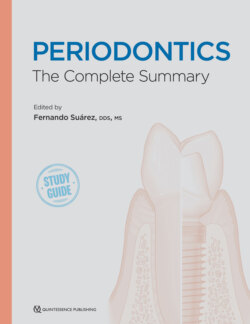Читать книгу Periodontics - Fernando Suarez - Страница 33
MOBILITY
ОглавлениеThe definition of tooth mobility is the movement of a tooth in its socket resulting from an applied force.1 Increase in tooth mobility is often a sign of periodontal breakdown and/or presence of excessive occlusal forces.1 Tooth mobility is detected by using the ends of two instruments (eg, mirror handle) on either side of the tooth and alternately applying forces.2 The most commonly used clinical index for tooth mobility is the Miller Index; using this index, mobility can be scored as the following2,24:
Class 0: Normal (physiologic) movement when force is applied. It has been defined as movement up to 0.2 mm horizontally and 0.02 mm axially.
Class I: First distinguishable sign of movement greater than “normal” or “physiologic.”
Class II: Movement of the crown up to 1 mm in any direction (buccolingual or mesiodistal).
Class III: Movement of the crown more than 1 mm in any direction (buccolingual or mesiodistal) and/or vertical depression (apicocoronal) or rotation of the crown in its socket.
